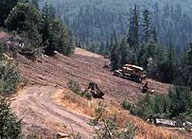
NPS photo.

NPS photo

NPS photo
Appropriate cleanup or treatment of hazardous waste prevents further impacts to natural and cultural resources. Small quantities of mining related materials, such as chemicals or fuels used in mining and milling, are completely removed. Large quantities of naturally occurring materials such as acid-generating waste rock may be treated on-site. Applications of lime may provide a buffer to prevent the generation of acids. In more severe cases, limestone drains or artificial wetlands filter heavy metals and reduce acidity. In worst-case scenarios, active water treatment systems may be necessary.
The goals for revegetation of mine sites in the National Park System are the restoration of native plant populations and patterns. The first consideration is the suitability of the soil for revegetation. In harsh conditions, topsoils, compost, or specific nutrients can be added. Specialized nurseries may be needed to propagate suitable plant materials. Sometimes, revegetation work is focused on establishing pioneering species to allow for natural succession. Time and nature then restore the natural productivity in the site.
Last updated: December 3, 2021
